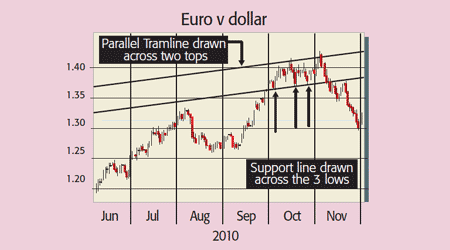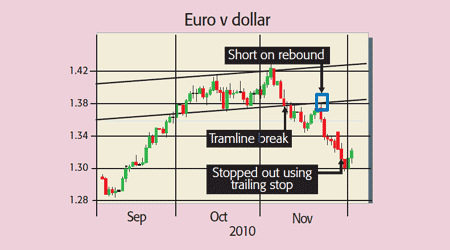How to play the currency markets
The foreign-exchange market moves quickly and it's highly risky. But if you know what you're doing, the rewards from trading currencies can be big. Tim Bennett explains.
With Europe's woes rarely out of the headlines, and the US printing more dollars, it's understandable why private investors are becoming more and more interested in the workings of the currency (or foreign exchange) markets. Trading currencies is risky it's speculative, short term, and often involves spread betting, which is in itself highly risky. But that's not to say you can't profit from it. Even if you're not interested in actively trading, it's worth understanding what drives currency movements these are, after all, by far the biggest financial markets in the world.
So what moves exchange rates? The short answer is, almost anything. Because the forex market is so liquid, exchange rates are in effect a highly sensitive barometer of a country's economic fortunes. But as some data points are far more important than others, here are the ones to watch.
Interest rates
MoneyWeek
Subscribe to MoneyWeek today and get your first six magazine issues absolutely FREE

Sign up to Money Morning
Don't miss the latest investment and personal finances news, market analysis, plus money-saving tips with our free twice-daily newsletter
Don't miss the latest investment and personal finances news, market analysis, plus money-saving tips with our free twice-daily newsletter
The 'price' for borrowing money is an interest rate. The rate that you or I pay on a mortgage, for example, is driven by the rate set by the central bank in the case of the UK, the Bank of England. The central bank rate is also one of the biggest influences on exchange rates. In general, the higher the rate of interest offered on one currency relative to another, the more demand for it there will be. This can be tempered by political risk factors (see below), but the broad principle works. So-called 'carry traders', for example, will borrow in a currency with a reliably low interest rate such as the yen and reinvest in a currency with higher rates. Resource-rich countries with 'commodity currencies' such as Australia have been popular targets, as their economies have been more robust than most.
Inflation data
One factor influencing interest rates is inflation. If inflation is rising, central banks tend to have to raise rates to tackle it. Inflation has been very subdued in the big Western economies over the past decade. But in the UK, for example, all eyes are on the Bank of England as consumer price index (CPI) inflation is still well above its 2% target.
Employment data
One key indicator of how strong an economy is and also of potential inflationary pressures is the employment situation. One of the most closely watched releases in the world is the monthly non-farm payrolls data from the US. This basically shows how many people employers have hired and fired each month. This matters: if employment is picking up, it suggests the economy is becoming healthier, which in turn suggests that rates could be set to rise and vice versa if unemployment is rising. So if the data disappoint markets, as they did in November (only 39,000 people were hired markets had expected 150,000), then chances are the US dollar will sell off.
GDP data
Gross domestic product (GDP) is one way to measure a country's wealth. Broadly speaking, it is the market value of goods and services a country produces. It is typically quoted in one of three ways. There's the absolute total. Were you to rank all countries globally, you'd find the US a good distance ahead here it generates around 20% of the planet's total recorded wealth. But GDP can also be measured per capita (per head). Here the US still scores well but so do rich, low-population countries such as Oman. But for currency traders, the third measure the GDP growth rate is arguably the most useful. This tells you whether a country's growth is picking up steam (the rate increases year on year) or losing momentum. That has a direct bearing on the strength of the currency.
Trade data
Most countries are either net importers (they buy more goods and services from other countries than they sell) or net exporters zzthe opposite). This has a bearing on the currency. If demand for, say, US goods (such as cars) or services (financial expertise, tourism, etc) is high among overseas buyers, they will need lots of dollars to pay for them. That in turn will tend to strengthen or raise the dollar against other currencies.
Then there's politics
Economic analysis can only take you so far. Currency traders also have to worry about political risk. Just as a perfectly sound company can be scuppered by management errors, politicians can wreak havoc when you least expect it. The eurozone is an obvious example. Despite the crises afflicting the likes of Greece and Ireland, you could argue that the euro has held up surprisingly well. The answer is largely political. To be more precise it's down to the Germans. The market believes on balance that the Germans won't let the euro project fail, despite the German chancellor, Angela Merkel's, assurances that German taxpayers won't be left to bail out every other member of the club. But clearly, this is open to question, and it leaves the euro vulnerable every time the European Central Bank or Merkel issues a soundbite.
Political risk is also a big feature of emerging markets. As a carry trader, it's all very well targeting an economy for investment because it offers a high rate of exchange. But you have to be aware that governments can change policies fast. One threat is that emerging economies will impose capital controls to stop 'hot' foreign money from driving inflation higher. That can result in speculative money flooding out as fast as it arrived, hammering the currency in the process.
And of course no trader can ignore the impact of quantitative easing (QE), where governments effectively 'print' money. In simple terms, the more of a particular currency there is, the less it is worth.
The trend can be your friend
So how do you profit from currency trading? Just like share trading, there are two approaches you can take. The first is bottom-up analysis, using economic data to try to judge the 'correct' price for a currency. But while this longer-term 'value investing' approach works well for stocks, it's not so easy to do over the shorter time frames that currency traders operate on.
Another is to spot a trend or a turning point, and jump in early. Once a major currency starts to move in one direction, the trend can be maintained for some time, especially if politicians try to fight the process. For example, sterling came under sustained attack from sellers when the UK government tried to prop up its price in 1992. Now many traders wonder how long the euro can survive in its current form. So, another key tool for any forex trader is the chart. MoneyWeek's spread-betting blogger, John C Burford, discusses one of his recent euro/US dollar trades below.
What makes forex different?
Anyone used to trading shares should be prepared for quite a ride if they switch to forex. It's a fast, highly liquid, 24-hour market. And the jargon can be baffling for a novice. But here are the key points. First, currencies rise or fall relative to one another, so they trade in pairs if you trade sterling against the US dollar, one rises and the other falls. It's a zero-sum game, unlike share trading.
Next, it's worth getting to know the three-letter acronyms used to describe each currency. Sterling is usually GBP, the US dollar USD, the yen JPY and so on. So if you want to bet on sterling rising against the US dollar you are looking for a price for the GBP/USD pair. Now, on to spreads. A typical quote for, say, GBP/USD might be 15583/15586. That tells you that if you have £1 to trade (the currency on the left), the relevant prices are $1.5583 (the bid) and $1.5586 (the offer). Don't forget, these are your broker's rates. So if you are selling (shorting) sterling, you'll get dollars using the bid rate. Equally, to buy sterling (go long), you'd need enough dollars calculated using the offer rate.
For traders or spread betters the rate on the right is the rate at which you'd 'buy' a bet on sterling rising or strengthening against the USD. When you come to end the bet and close the trade, you'll do so at the updated bid rate. The difference is your broker's 'spread' in this case three 'pips' or 'ticks'. That's the smallest movement in the rate recognised by your broker. In this instance that's $0.0001.
For traders, spread bets are probably the easiest albeit a risky way to trade forex. You can read more about how a sample trade works below. But before diving in, do take time to get comfortable with spread bets using your broker's trading simulator (usually free). And as you can lose a lot more than your initial stake, you should definitely consider using stop-losses.
Alternative ways to play currencies
The most obvious way to hedge foreign-exchange exposure is to buy and hold the currency you're worried about. If you travel regularly to, say, the US, then it makes sense to open a US dollar account. You can open a foreign currency account through most banks. But as a way to make money as an investor, cash foreign currency accounts are not ideal. The costs of moving money around, coupled with low interest rates, may wipe out any forex gains you make.
An alternative is an exchange-traded currency (ETC) product, which tracks either an individual currency or a basket of them. But make sure you understand exactly what these ETCs do before you buy. One issue is that the underlying currency is usually the US dollar. So, for example, try to track the Brazilian real as a UK investor and you may find you are exposed to both the GBP/USD and USD/BZF rates, rather than the GBP/BZF rate.
A better bet if you're looking for a profitable currency trade that doesn't involve spread-betting might be to buy gold. With more money-printing being threatened by the US, and the euro in danger of imploding, the fear of debasement of paper currencies in general suggests that gold could still reach higher highs, even if it corrects in the short term.
This article was originally published in MoneyWeek magazine issue number 516 on 10 December 2010, and was available exclusively to MoneyWeek subscribers. To read all our subscriber-only articles right away, subscribe to MoneyWeek magazine.
How I turned £1 into £620 in just one week

By John C Burford
The daily volumes traded in currency markets are vast. Because the most heavily traded currencies are so liquid, well-established technical analysis techniques can be very effective in working out the timing of your trades.
I like to use classic charting techniques, as well as Elliott wave and Fibonacci retracement concepts (you can learn more about these terms at my blog). On most spread-betting platforms, you can trade in a range of currencies, including more exotic pairs. However, I stick to the majors. These have the tightest spreads (the gap between what it costs you to buy, and what it costs you to sell), they are very liquid, and the relevant macro-economic data are readily available, which isn't true of a currency such as the South African rand, for example.
Here is a great recent example in spread-betting the euro (EUR) versus the US dollar (USD). This is one of the most heavily traded 'crosses', and you can spread-bet it with a very tight spread (ie, it's cheap to trade). In the summer, the EUR/USD was staging a recovery from the huge falls earlier this year. The dollar had been riding high against the euro, during the Greek debt crisis. But in June, the market turned suddenly, as the focus shifted to the Federal Reserve's plan to flood the markets with yet more QE dollars. I watched from the sidelines. I was expecting the euro to turn lower again (as was indicated by my Elliott wave analysis), and the focus to shift back to the eurozone's sovereign debt problems. But during most of October as the chart on the right shows the market traded in a congestion zone between $1.37 and $1.42, even as the jitters over Ireland took hold. In early November, I was able to draw a sound 'support' line (indicating an area where the market kept bouncing) across the three 1.37 lows and the 'resistance' line (an area it couldn't get into) through the 1.42 tops. These pairings are called 'tramlines'.

To me, this action looked toppy, but I was willing to wait for a clear signal before jumping on the short side. Already, sentiment had completely swung against the dollar it was the most hated market on the board (except for cash, that is). The euro looked ripe for a big correction, as there were few bulls left and it had rallied from $1.19 to $1.42 in less than six months. I was expecting it to give back at least 50% of that sharp gain, based on the record bullish consensus in October. That would take it to the $1.31 area delivering a great profit if a trade in the $1.37 area worked out.
A clue to a possible top was the break of my lower tramline on 10 November. I watched as it fell below and then rallied back towards the underside of the line. This is very typical behaviour and a healthy sign. The important thing to watch for is what happens after the market has pulled back to the line. On Friday 19 November, I decided to enter a resting sell order in the rolling EUR/USD near the line at $1.3780 (that is, when and if the EUR/USD rate moved to $1.3780, my short trade, would be triggered). I allowed for a risk of 100 pips to $1.3880. In other words, that's where I set my stop-loss, as I felt that if the euro climbed that high, my theory would have been proved wrong; remember, trading is all about probabilities there are no certainties. On the following Monday (22 November), my order was filled on a brief spike.

Then the euro started falling. I quickly moved my protective stop to break-even point (that is, I shifted the stop-loss so that my trade would be closed automatically should the euro recover back to $1.3780). This meant I now had a free ride. I like to use this money management rule it enables me to sleep at night. One drawback is that it can take me out of a promising trade too early. But that's the price I'm willing to pay for peace of mind. As the market dropped quickly through the $1.35 level, I moved my protective stop down each day to a point just above the highs of each day's trading, thus protecting my gains all the way down. This is a 'trailing stop' method, and it gives me the discipline to exit a trade at a logical point. I had no idea whether the market would continue to crash or not. On 1 December, the market rallied to my $1.3160 stop and took me out of the trade for a clean, quick profit of 620 points, or £620 per £1 bet in a little over a week. All by using elementary charting concepts combined with sensible money management.
NB: Don't miss John's next bit of trading advice. To receive his spread betting blog posts by email, as soon as he's written them, just sign up to MoneyWeek Trader here .
Get the latest financial news, insights and expert analysis from our award-winning MoneyWeek team, to help you understand what really matters when it comes to your finances.
Tim graduated with a history degree from Cambridge University in 1989 and, after a year of travelling, joined the financial services firm Ernst and Young in 1990, qualifying as a chartered accountant in 1994.
He then moved into financial markets training, designing and running a variety of courses at graduate level and beyond for a range of organisations including the Securities and Investment Institute and UBS. He joined MoneyWeek in 2007.
-
 Rightmove: Asking prices set to rise 2% in 2026 after post-Budget market rebound
Rightmove: Asking prices set to rise 2% in 2026 after post-Budget market reboundBuyers and sellers who held off in anticipation of the Budget will come back to the market and contribute to asking prices increasing next year, according to Rightmove
-
 Coreweave is on borrowed time
Coreweave is on borrowed timeAI infrastructure firm Coreweave is heading for trouble and is absurdly pricey, says Matthew Partridge